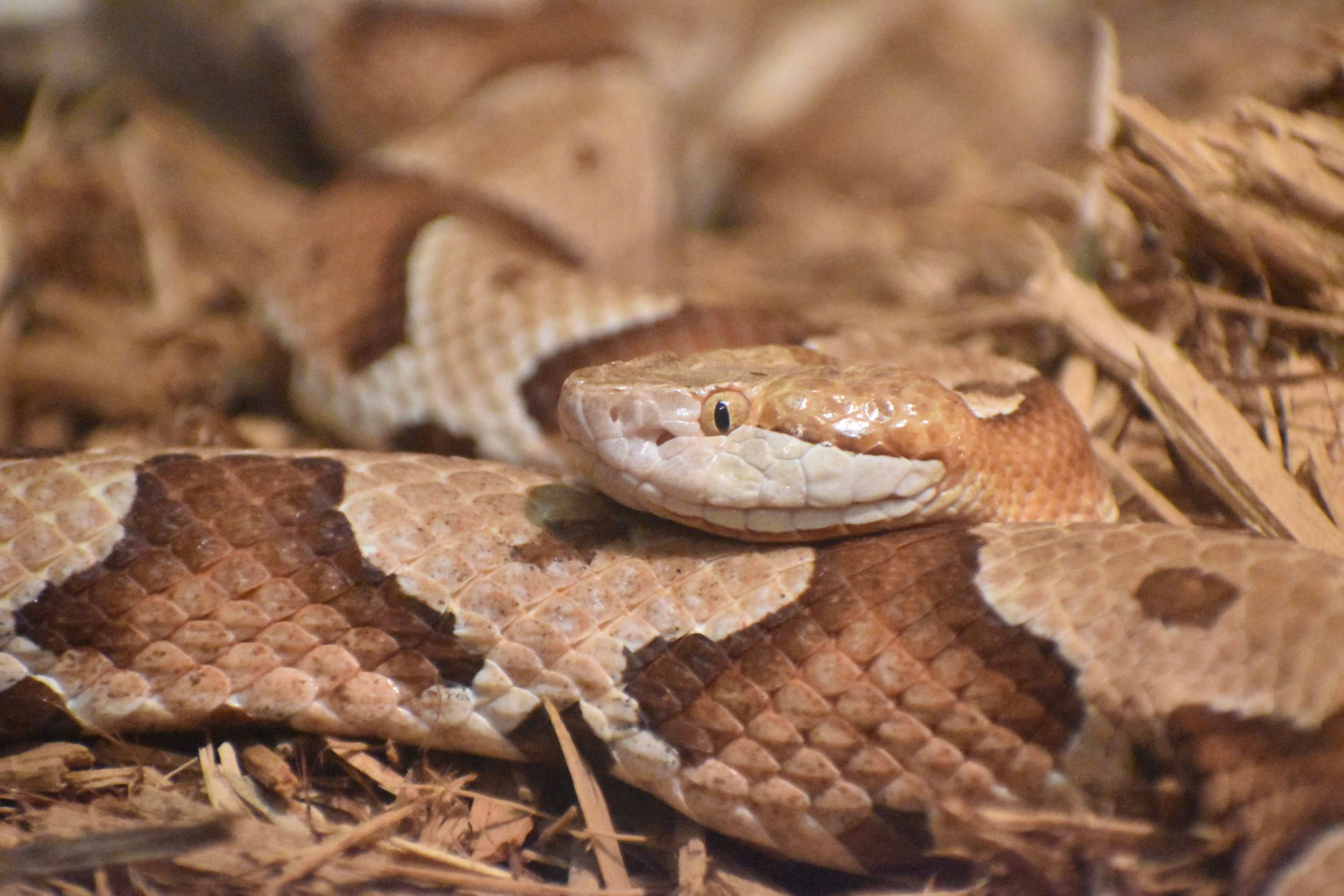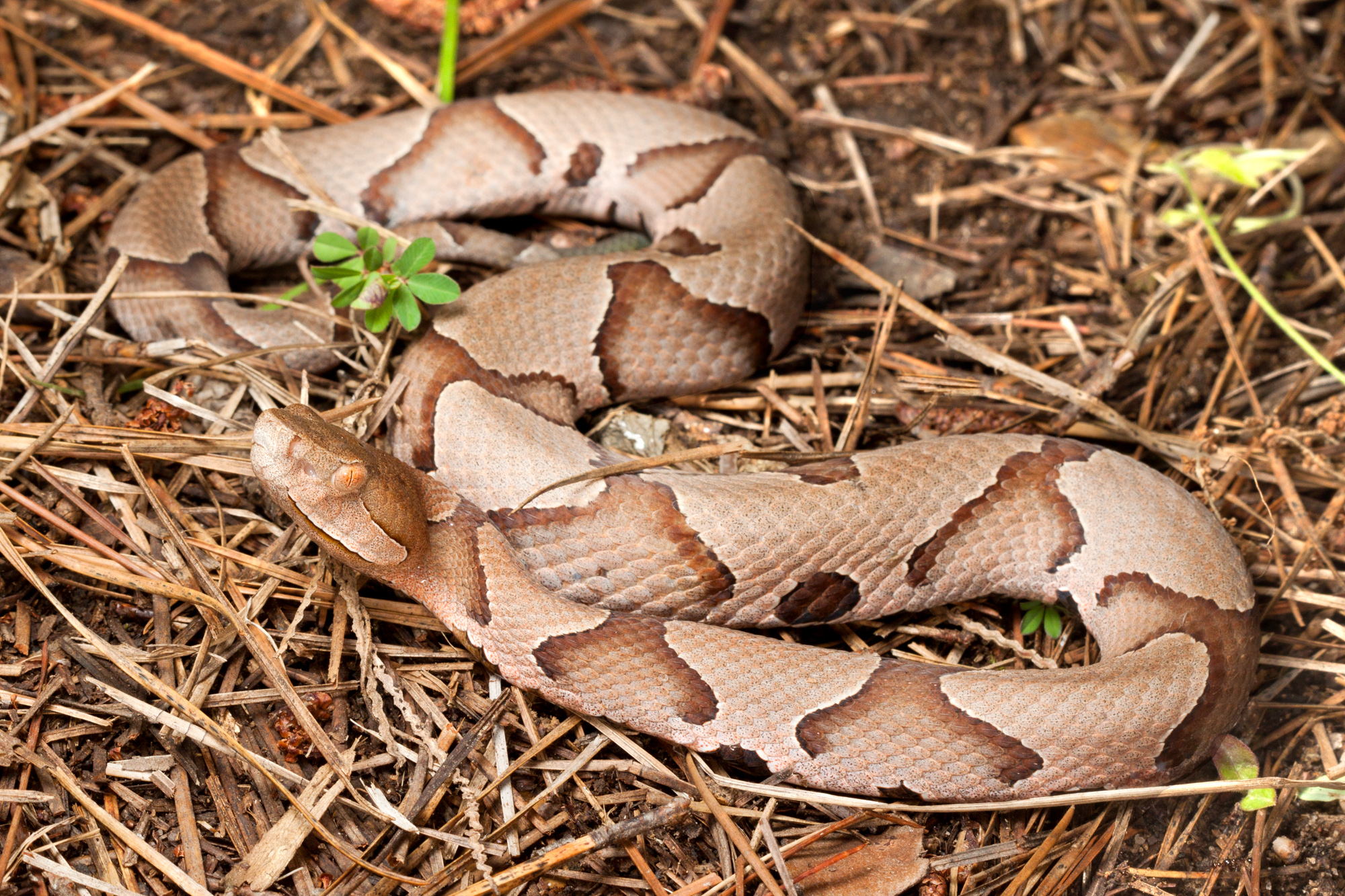Copperhead Snake
Agkistrodon contortrix is a species of venomous snake endemic to Eastern North America, a member of the Crotalinae (pit viper) subfamily. The common name for this species is the copperhead. The behavior of Agkistrodon contortrix may lead to accidental encounters with humans. Five subspecies are currently recognized, including the nominate subspecies described here.
Adults grow to an average length (including tail) of 20–37 in. Some may exceed 3.3 ft, although that is exceptional for this species. Males are usually larger than females. Good-sized adult males usually do not exceed 29 to 30 in, and females typically do not exceed 24 to 26 in. In one study, males were found to weigh from 3.58 to 12.10 oz, with a mean of roughly 6.96 oz. According to a different study, females have a mean body mass of 4.23 oz. The maximum length reported for this species is 53.0 in for A. c. mokasen.
The body is relatively stout and the head is broad and distinct from the neck. Because the snout slopes down and back, it appears less blunt than that of the cottonmouth, A. piscivorus. Consequently, the top of the head extends further forward than the mouth.
The color pattern consists of a pale tan to pinkish tan ground color that becomes darker towards the foreline, overlaid with a series of 10–18 crossbands. Characteristically, both the ground color and crossband pattern are pale in A. c. contortrix. These crossbands are light tan to pinkish tan to pale brown in the center, but darker towards the edges. They are about 2 scales wide or less at the midline of the back, but expand to a width of 6–10 scales on the sides of the body. They do not extend down to the ventral scales. Often, the crossbands are divided at the midline and alternate on either side of the body, with some individuals even having more half bands than complete ones. A series of dark brown spots is also present on the flanks, next to the belly, and are largest and darkest in the spaces between the crossbands. The belly is the same color as the ground color, but may be a little whitish in part. At the base of the tail there are 1–3 (usually 2) brown crossbands followed by a gray area. In juveniles, the pattern on the tail is more distinct: 7–9 crossbands are visible, while the tip is yellow. On the head, the crown is usually unmarked, except for a pair of small dark spots, one near the midline of each parietal scale. A faint postocular stripe is also present; diffuse above and bordered below by a narrow brown edge.
It is found in the United States in the states of Alabama, Arkansas, Connecticut, Delaware, Northern Florida, Georgia, Illinois, Indiana, Iowa, Kansas, Kentucky, Louisiana, Ohio, Oklahoma, Maryland, Massachusetts, Mississippi, Missouri, Nebraska, New Jersey, New York, North Carolina, Pennsylvania, South Carolina, Tennessee, East Texas, Virginia and West Virginia. In Mexico, it occurs in Chihuahua and Coahuila. The type locality is "Carolina". Schmidt (1953) proposed the type locality be restricted to "Charleston, South Carolina".[2]
Unlike some other species of North American pit vipers, such as timber rattlesnake and Sistrurus catenatus, Agkistrodon contortrix has mostly not reestablished itself north of the terminal moraine after the last glacial period (the Wisconsin glaciation), though it is found in southeastern New York State and southern New England, north of the Wisconsin glaciation terminal moraine on Long Island.
Within its range it occupies a variety of different habitats. In most of North America it favors deciduous forest and mixed woodlands. It is often associated with rock outcroppings and ledges, but is also found in low-lying swampy regions. During the winter it hibernates in dens, in limestone crevices, often together with timber rattlesnakes and black rat snakes. In the states around the Gulf of Mexico, however, this species is also found in coniferous forest. In the Chihuahuan Desert of west Texas and northern Mexico, it occurs in riparian habitats, usually near permanent or semipermanent water and sometimes in dry arroyos (brooks).

By Laura Wolf. CC BY 2.0, via Flickr

By Natalie McNear. CC BY-NC 2.0, via Flickr
